

2008: Why you should have a website
I introduced RDFa as a new technology: Now adopted by Yahoo, Google, US and UK governments, Drupal, just to name a few.
2009: Never is a long time
LED lamps: I quoted "Affordable 60-watt-equivalent LED in 2 years". In fact Albert Heijn has been selling them since October (if you consider €17 affordable).
Linux: I quoted "Linux will outship Windows on new PCs in 2009". Clearly he was premature...
USB stick prices:
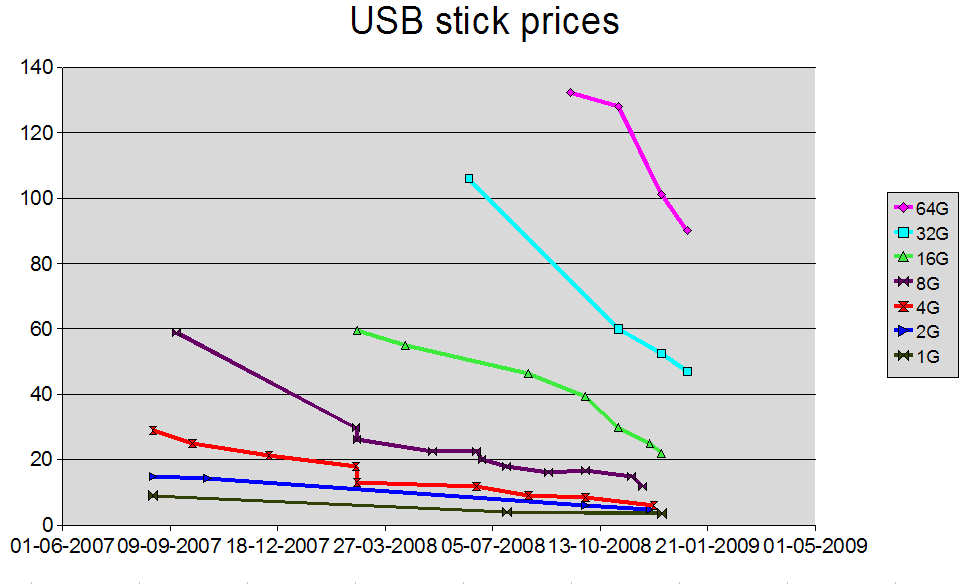 In fact,
since then prices rose slightly, and only now are dropping below the price of a
year ago (32G now under €40).
In fact,
since then prices rose slightly, and only now are dropping below the price of a
year ago (32G now under €40).
We all know Moore's law. Things double at regular intervals.
It is an exponential growth.
Note that a doubling per 2 years is the same as a 10 fold increase every 6 and a bit years; it is the doubling that is important, less the period.

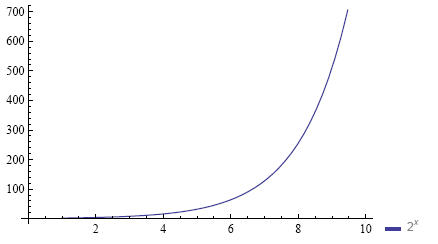

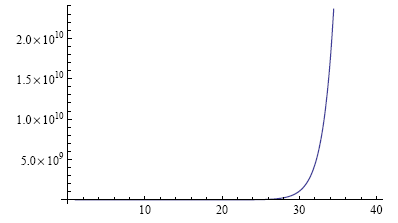 Note how there seems to be nearly no action before iteration 26.
Now look back at the 20 iterations graph. This is just a problem of scaling,
and why we use logarithmic scales for exponential functions.
Note how there seems to be nearly no action before iteration 26.
Now look back at the 20 iterations graph. This is just a problem of scaling,
and why we use logarithmic scales for exponential functions.
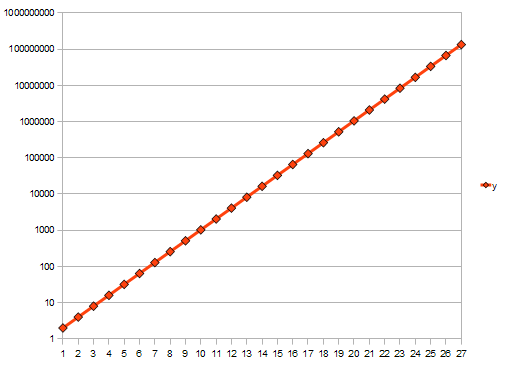


Often people don't understand the true effects of exponential growth.
A BBC reporter recently: "Your current PC is more powerful than the computer they had on board the first flight to the moon". Right, but oh so wrong.
Take a piece of paper, divide it in two, and write this year's date in one half:
Now divide the other half in two vertically, and write the date 18 months ago in one half:
Now divide the remaining space in half, and write the date 18 months earlier (or in other words 3 years ago) in one half:
Repeat until your pen is thicker than the space you have to divide in two:
This demonstrates that your current computer is more powerful than all other computers you have had put together (and way more powerful than the computer they had on board the first moonshot).
Each step up in a power of ten is called an order of magnitude change.
"An order of magnitude quantitative change is a qualitative change"
Half way between 100 and 1000 on a logarithmic scale is about 300 (316.2 to be more exact).
So we say that for an order of magnitude, 300 ≅ 100
Also, since we are only talking orders of magnitude, it doesn't really matter what unit of currency we use, so I will use ¤, which believe it or not is the generic "currency" symbol in Unicode (and Latin 1).
2009 was the 400th anniversary of an Englishman, Henry Hudson, working for a Dutch company, discovering the island of Manhattan. Then, and for centuries after, all trans-Atlantic shipping was done with sailing ships.

When steam ships were introduced they were not reliable enough to travel trans-Atlantic distances, they couldn't travel far without breaking down, and they were inclined to blow up.
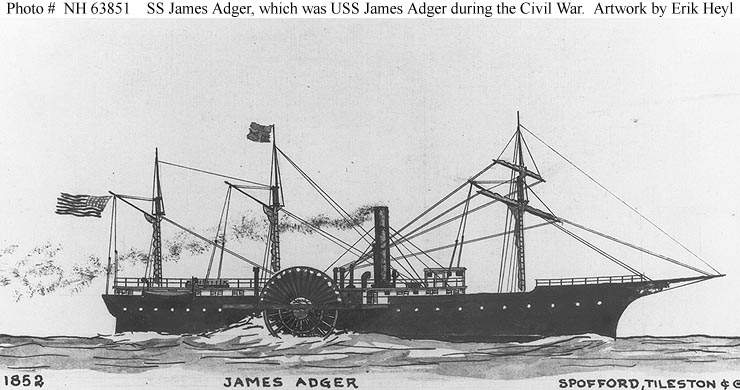
But steam ships were able to find a niche in lake and river transport, where the distances were short, and where they had the advantage of being able to travel against the wind and on wind-still days.
Once in the niche they could improve reliability until they were able to travel trans-Atlantic.
Once that happened, all shipping switched to steam, and all the companies producing trans-Atlantic sailing ships went out of business; not one survived into the 20th century.
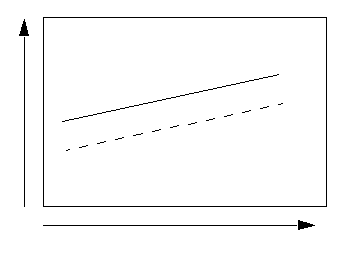 Typically, technologies improve gradually and continually over time. These are
sustaining improvements. An existing technology fulfils or exceeds the
market's needs.
Typically, technologies improve gradually and continually over time. These are
sustaining improvements. An existing technology fulfils or exceeds the
market's needs.
 Steam ships on the other hand are an example of a disruptive
technology, a term introduced in the excellent book The Innovator's
Dilemma by Clayton M. Christensen.
Steam ships on the other hand are an example of a disruptive
technology, a term introduced in the excellent book The Innovator's
Dilemma by Clayton M. Christensen.
A disruptive technology when introduced is able to do similar things as an existing technology, but has one or more disadvantages that make it less desirable for the existing market, such as higher price, lower performance, lower reliability etc.
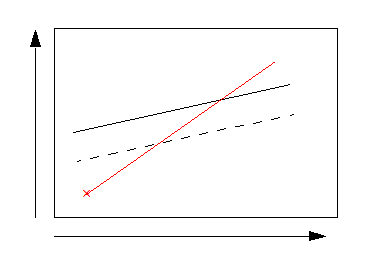 If that were all, then of course no one would buy it, but a disruptive
technology always has at least one advantage over existing technologies that
despite its disadvantages allows it to find a niche, and therefore survive.
If that were all, then of course no one would buy it, but a disruptive
technology always has at least one advantage over existing technologies that
despite its disadvantages allows it to find a niche, and therefore survive.
Whilst in this niche it is able to improve, typically more rapidly than the existing technology, until it performs equally with the existing technology, or at least sufficiently for the market needs, but with the added advantages that it had that allowed it to survive.
As a result the existing market steps over to the new technology and the old one dies (typically taking the companies producing the technology with it).
It is difficult to believe that the change from 8 inch to 5¼ inch disk was a disruptive innovation, but they represented different technologies. Compare the two when 5¼ inch disks were introduced in 1981:
| 8 inch | 5¼ inch | |
|---|---|---|
| Capacity | 60 MB | 10 MB |
| Volume | 10 litre | 2.5 litre |
| Weight | 10 kg | 2.75 kg |
| Access time | 30 µs | 160 µs |
| Cost | $3000 | $2000 |
| Cost per Mbyte | $50 | $200 |
When a disruptive technology is first introduced, it looks pathetic to the existing market. "Why would anyone want that."
Disruptive technologies are almost never introduced by an existing company, in the few cases that an existing company has seen the risk, and been successful, it has been by spinning off a new company or division.
Reminds me of: "First they ignore you, then they ridicule you, then they fight you, then you win." (Attributed to Gandhi - on a completely different subject)
Thanks to the effects of Moore's law, each decade or less, there has been an order of magnitude increase in computing power.
This has enabled a new generation of computer to appear.
"An order of magnitude quantitative change is a qualitative change"
As a result we have used each generation of computer in a new way, not just for more of the same.
From the 1950's the way computing was done was on mainframes. These were room-sized machines, shut off to the outside world, and would cost millions. They were produced by the likes of IBM, Univac, Burroughs, Control Data, NCR, Honeywell, and others.
They were so expensive that many companies would lease computers rather than buy them.
They often came with 'free' programmers into the bargain.
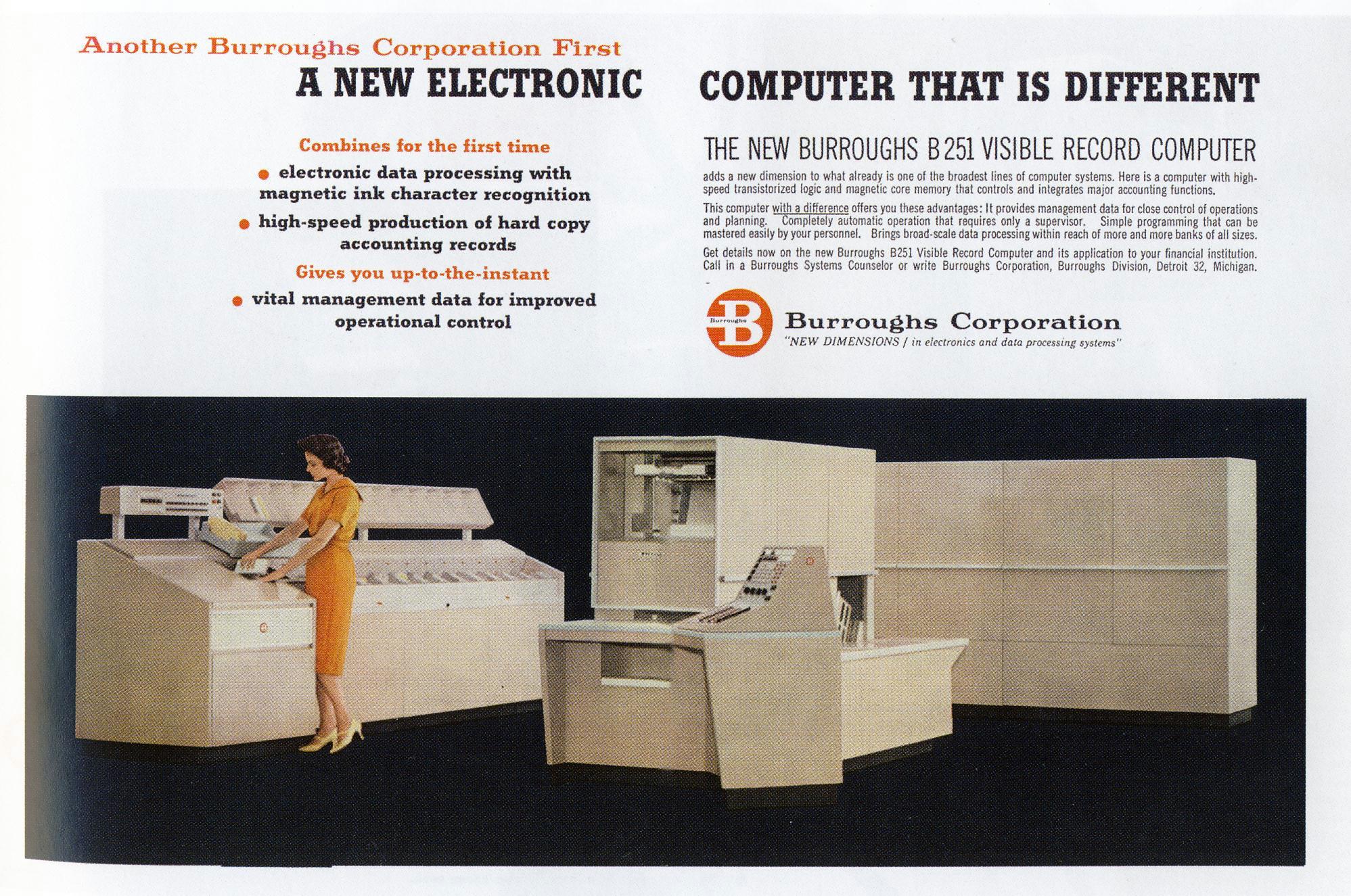
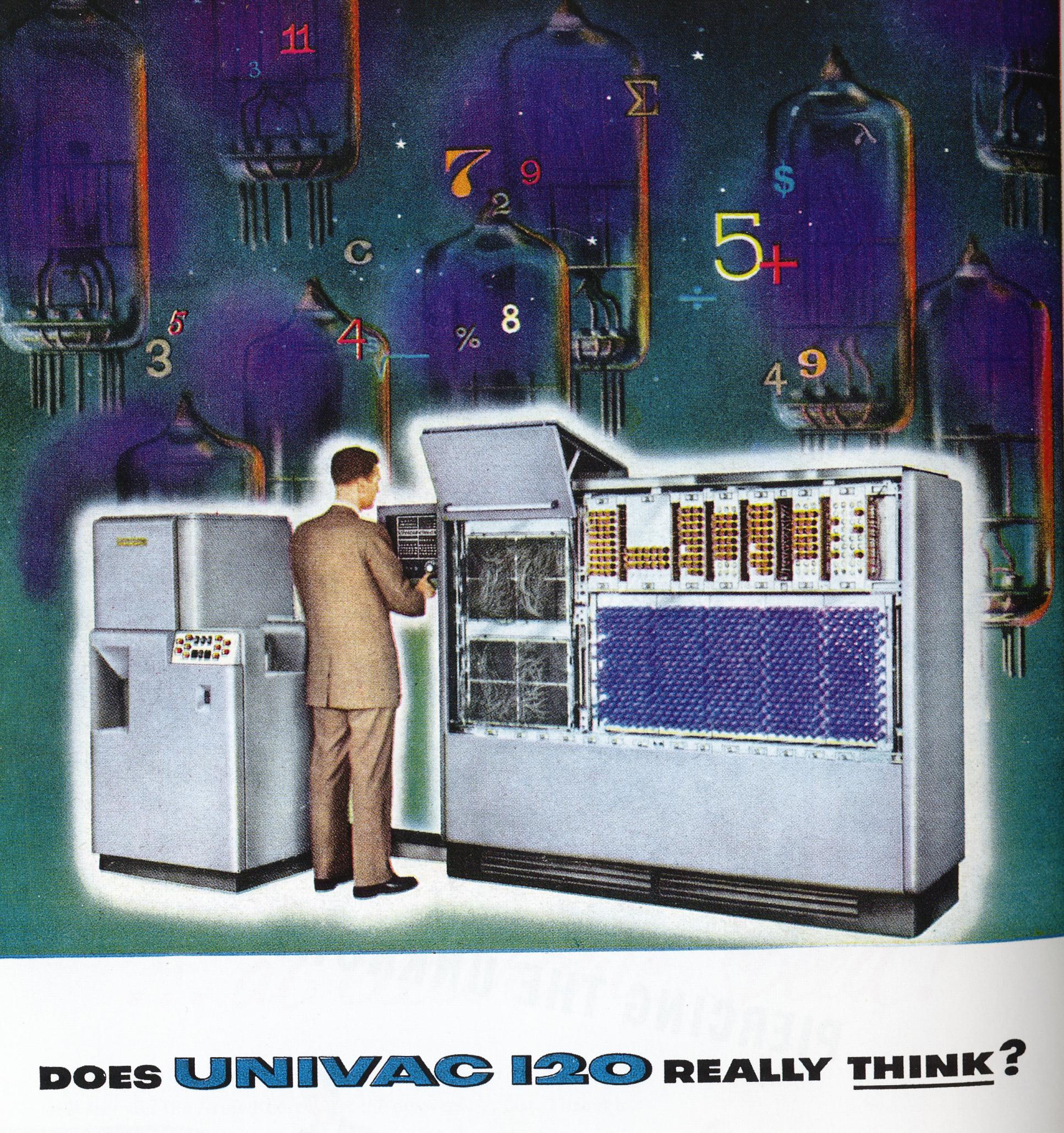
Let me describe how I had to use a mainframe in my first programming job.
I would think out my programs on pieces of paper, then write them out, before copying them onto specially printed sheets
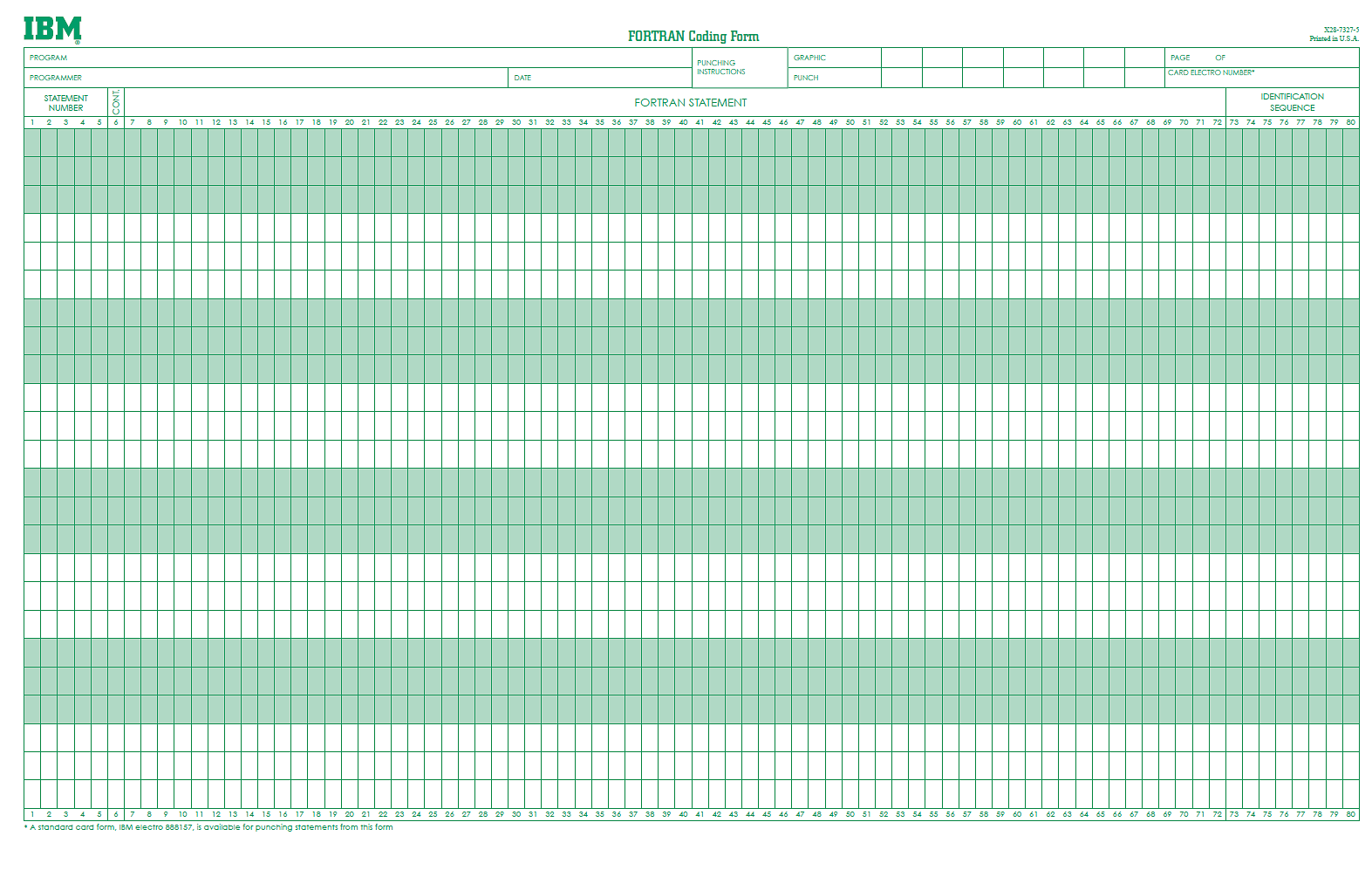
 Which sheets I would give to a punch-card operator to type
up, who would pass it on to the verifier operator to check it.
Which sheets I would give to a punch-card operator to type
up, who would pass it on to the verifier operator to check it.
Why use two extra people? Because it was cheaper than running an incorrect program on the computer!
When ready I would take my pack of cards and walk over to the computer centre where the mainframe computer was kept. (Of the order of 100k bytes per box).
I would type up a special header card describing the job and the resources needed by my job, and then hand over the cards to an operator who would put them into the queue of jobs to be run.
Then I would return to my office, and work on some other problem.
About an hour later I could walk back to the computer centre, and if I was lucky my cards and the line-printer output from the job would be waiting for me to pick up.

I would then quickly peruse the output. If there had been a syntax error, I could correct the cards involved and resubmit the job immediately. If the job had run satisfactorily, or there was a problem that needed more thought, then I would walk back to my office.
If I was unlucky though, my job wasn't ready. I would then look at the status of the jobs to be run from a printout that was hung on the wall at regular intervals, in order to get an impression of how much longer I would have wait. Jobs that needed a minute or less of computer time got priority; if you needed more, you often had to wait a long time before your job arrived (more than a day).
This was the typical life of a programmer of a mainframe computer. Compared with modern programming, you got lots of exercise and fresh air walking back and forth to the computer centre carrying heavy boxes of cards.
Starting in the 60's but picking up momentum in the 70's, a new type of computer started appearing, the minicomputer. These were more cupboard-sized machines, costing of the order of ¤100,000, and manufactured by the likes of DEC, Data General, Prime, and Wang.
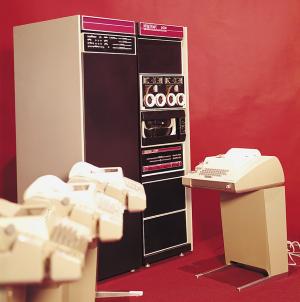 The disadvantage of these machines were that they were
slower, and had few resources (memory, disk) than the mainframes. But the
advantage was that they were cheap, and you could have them in the lab. You
still had to share, but it was nearby, and you got instant turnround once you
were on it.
The disadvantage of these machines were that they were
slower, and had few resources (memory, disk) than the mainframes. But the
advantage was that they were cheap, and you could have them in the lab. You
still had to share, but it was nearby, and you got instant turnround once you
were on it.
Univac, Burroughs, Control Data, NCR, Honeywell, DEC, Data General, Prime, and Wang. Why aren't they around any more?
This is the result of the typical response to disruptive technologies.
An existing company with an existing group of customers is unlikely to see the new technology as tempting: it is under-powered, and worse, has lower profit margins.
It usually takes a new company to come along (such as DEC with the mini computer) to develop a new technology. Very rarely does an existing company successfully make the transition to the new technology. That's why it is called 'disruptive'.
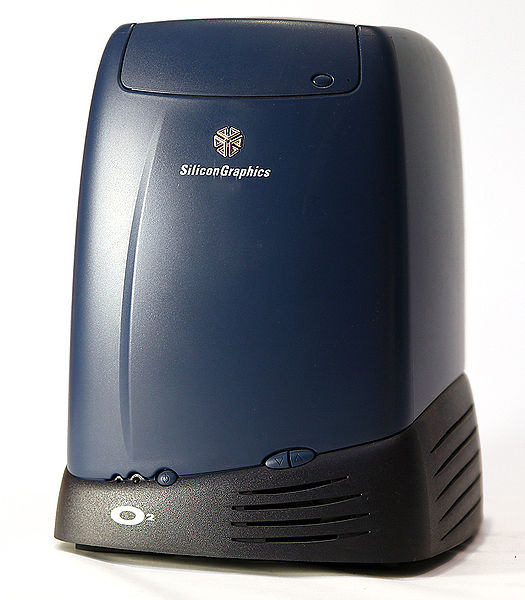
Starting in the 70's but picking up momentum in the 80's came the Workstation, which could go on the desktop of the programmer in the office, and were known as 3M machines:
They were made by the likes of Sun, Xerox, Perq, Lisp Machines. Now at last programmers had machines of their own.
Starting in the late 70's, came the PC, the first computer to make its way into the home (and the briefcase). It cost of the order of ¤1000, and was made by the likes of IBM, Apple, Compaq, Atari, Commodore.
![Apple ][](800px-Apple_II.jpg)
Since we have seen
¤1000000 mainframes
¤100000 minis
¤10000 workstations
¤1000 PCs
We really should expect the emergence of the ¤100 machine
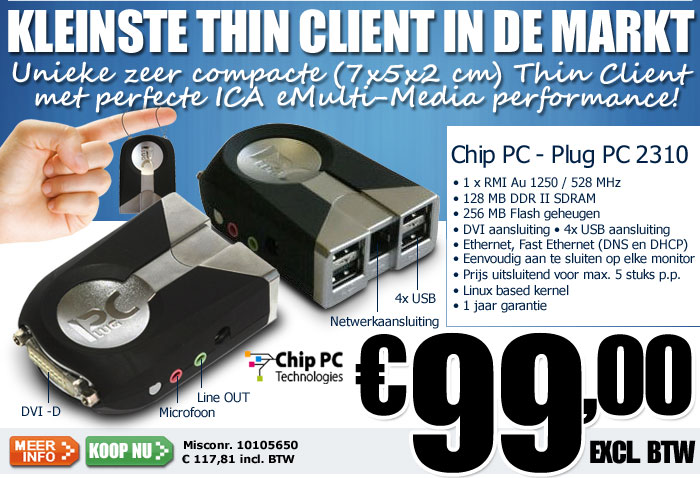
Netbooks too are of the order of ¤100.
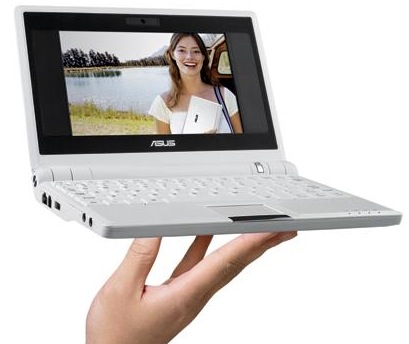
Ridicule: Michael Dell: Netbooks go sour after 36 hours "We see a fair amount of customers not really being that satisfied with the smaller screen and the lower performance - unless it's like a secondary machine or it's a very first machine and the expectations are low," he said. "But as a replacement machine for an experienced user, it's not what we'd recommend. It's not a good experience, and we don't see users very happy with those."
Real usage: they have found a niche, so PC manufacturers beware!
Expectation: netbooks/tops will grow to destroy PCs (you might think they are the same, just like 5¼ inch disks and 3½ inch disks seemed the same.)
Expectation: some PC companies will die (Toshiba apparently already going - to Asus)

When the XBox was first introduced (2000, $300), many people wondered why we
couldn't have computers at that price.
And we did have a £100 computer 20 years before that in 1980:
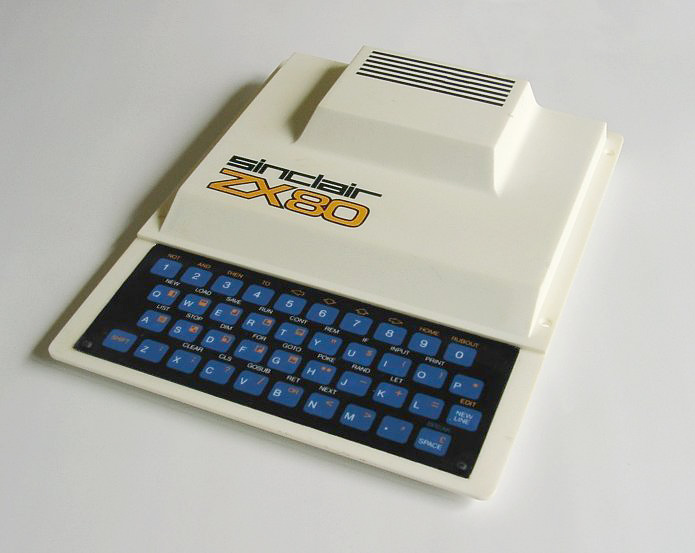
Carry round, plug into larger screens and keyboards.
No longer one computer per family: really do need new operating systems
Use NAS for family storage
Bandwidth is doubling per year (remember floppies were 64kB/s): use NAS or cloud uniquely. Google docs, Flickr, Facebook.
Google OS is coming
= Return of the thin client
Should we be thinking of a soon-to-appear ¤10 computer, and if so, how will we use it?
My first pocket calculator cost (my employer) of the order of ¤100 (about 1/10th of my annual salary at the time). Now such a calculator is essentially free (I have a drawer-full of such things that have been given to me).
Typically people expect that we will use new technologies in the same way we use existing ones.
Steam engines: One engine, lots of pulleys to distribute the power over the factory.
Assumed the same would happen with electric engines: one engine in the huse with pulleys taking the power to where you needed it.
Vacuum cleaner point in every room.
Same with mainframes. Assumed 5 would be enough. Why would people want personal computers? They don't need to do payrolls!
Uses around the home. How many CPUs do you have in your home now?
One computer per light fitting? Why not?
Might we plug it in like a USB memory stick? I doubt it.
Mp3 video player with colour screen: under €30
Keyring picture frame: €10
Keyring picture frame: €5
These examples all have a screen, a USB port, and can do reasonable amounts of processing.
An order of magnitude quantitative change is a qualitative change.
We have seen 5 different generations of computers since the 50's. We should anticipate the next one.
And how about the ¤1 computer?